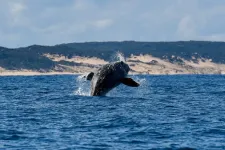(Press-News.org) Bald eagles are often touted as a massive conservation success story due to their rebound from near extinction in the 1960s.
But now a highly infectious virus may put that hard-fought comeback in jeopardy.
Published in Nature’s Scientific Reports, new research from the University of Georgia showed highly pathogenic avian influenza, also known as H5N1, is killing off unprecedented numbers of mating pairs of bald eagles.
“Even just one year of losses of productivity like we’ve documented regionally is very concerning and could have effects for decades to come if representative of broader regions,” said Nicole Nemeth, lead author of the study and an associate professor in the College of Veterinary Medicine. “There were nights where I couldn’t sleep based on what we were hearing and seeing. We have already lost unprecedented numbers of wild birds due to this virus in the U.S. and it appears here to stay.”
Less than half of Georgia bald eagle nests fledged one chick in 2022
The researchers found that just under half of bald eagle nests along coastal Georgia successfully fledged at least one eaglet in 2022. That’s 30% below average for the region.
The study also showed the success rate for nests was halved in one Florida county, dropping to 41% from an average of 86.5%. Another Florida county experienced a less dramatic but still concerning decrease from an average of approximately 78% to 66.7%.
“We had reports from people who faithfully monitor eagle nests year after year with these heartbreaking stories of an adult eagle found dead below their nest. Within a few days, often its mate and the chicks were also found dead below the nest. It is clear the virus is causing nest failures,” said Nemeth, who is part of the UGA-based Southeastern Cooperative Wildlife Disease Study (SCWDS).
The collaboration is the first diagnostic and research service established specifically to investigate wildlife diseases.
Number of infected wild birds likely an undercount
In April 2022, SCWDS researchers confirmed highly pathogenic avian influenza had hit Georgia’s eagle populations for the first time.
The three dead eagles were found in Chatham, Glynn and Liberty counties in March.
At the time, the U.S. Department of Agriculture (USDA) had confirmed around 660 cases of the H5N1 virus in wild birds, only 11 of which were from Georgia.
That number has since skyrocketed to more than 6,200 reported cases across the country, according to the USDA’s Animal and Plant Health Inspection Service.
Those cases include a variety of vultures and other raptors, waterfowl like geese and ducks, as well as other aquatic birds like pelicans and herons, and even some songbirds, though they are less common victims of the virus. (Tens of millions of commercially farmed poultry have died or been culled due to risk of infection.)
“I think the number of wild bird cases is drastically underreported,” Nemeth said. “People will submit one snow goose, for example, and it will test positive for the virus. And then they’ll tell you, ‘Well, there are thousands of geese dying at the same site.’ But it only goes down as one infected bird.”
H5N1 doesn’t pose massive threat to humans but may to other species
The birds at biggest risk of infection are those that live in coastal or other aquatic areas inland or prey on other birds that do.
The virus can persist in water for over a year, given the proper conditions. While not a risk to people, birds can pick up the virus from spending time in the water and carry it to new locations through migration.
Raptors like eagles and vultures then catch the virus when they consume the infected birds.
“Worst case scenario, we get into a scary place with some of these bird species,” Nemeth said. “We could see a lot more decline in the numbers of eagles, raptors, waterfowl and other birds than what we’ve already seen. It could be devastating.”
Bears, red foxes and coyotes among animals infected with virus
Avian influenza has hopped species as well.
H5N1 has infected wild mammals such as red foxes, coyotes, racoons, seals, opossums and even some bears in North America. However, very few people have been infected with the virus in the U.S. and have recovered with minimal symptoms, according to the Centers for Disease Control and Prevention.
“A virus that can spread and be maintained as this virus can, it’s everywhere now,” Nemeth said. “We can’t contain the virus, and we can’t vaccinate wild birds. But we can document the losses and try to help conserve affected species and populations the best we can.”
The study was co-authored by the University of Georgia’s Mark Ruder, Rebecca Poulson and David Stallknecht. Additional co-authors include Robert Sargent of the Georgia Department of Natural Resources, Shawnlei Breeding of Audubon’s EagleWatch, Meaghan Evans, Jared Zimmerman, Rebecca Hardman, Mark Cunningham of Florida Fish and Wildlife Conservation Commission and Samantha Gibbs of U.S. Fish & Wildlife.
END
Bald eagles aren’t fledging as many chicks due to avian influenza
As more eagles die from H5N1, researchers concerned virus may undo decades of conservation efforts
2023-03-02
ELSE PRESS RELEASES FROM THIS DATE:
New podcast gives parents a “Pediatrician Next Door”
2023-03-02
Imagine if harried parents could get the scientific and clinical expertise of a pediatrician just by walking only a few steps next door. That’s the premise of a new podcast, The Pediatrician Next Door, by Dr. Wendy Hunter, M.D. She brings decades of experience in emergency and primary pediatric care to answer burning questions that parents are reluctant to ask.
“In the emergency room, I saw a great many frustrated parents and their kids who didn’t always get their questions answered by their pediatrician because there just wasn’t time in the clinic,” said Dr. Hunter. “Or, they didn’t have access to their ...
Existing chest scans offer new opportunities for predicting surgical risks
2023-03-02
Instead of special heart scans, physicians can use images of the chest captured months earlier, and for other reasons, to estimate patients’ risk of heart attack or death during several kinds of major surgeries, a new study shows.
Researchers at NYU Grossman School of Medicine analyzed existing computed tomography (CT) scans to estimate levels of hardened (calcified) fatty plaque deposits in the heart’s three largest blood vessels. They found that patients with greater buildup of this plaque had higher chances of developing serious health issues following surgery.
Major surgeries, which usually ...
Using radar to predict Alzheimer’s disease and fall accidents
2023-03-02
Researchers at Chalmers University of Technology in Sweden have developed a method for predicting fall accidents and cognitive illnesses such as Alzheimer’s disease by reading a person’s walking pattern with the aid of a radar sensor. The small sensor can be attached to furniture, walls and ceilings, both in the home and in a healthcare setting.
“Our method is both precise and easy to use. It can help healthcare staff to carry out a more reliable risk analysis and tailor interventions to achieve a significant effect early on. Hopefully it can ...
2023 GOLD Report proposes a new definition of chronic obstructive pulmonary disease
2023-03-02
New York, NY – March 02, 2023 – Despite COPD’s pervasiveness, it is generally assumed that the main instigator in its development is tobacco smoking. The 2023 Global Initiative for Chronic Obstructive Lung Disease or GOLD report is proposing a new definition of COPD, one that acknowledges the key pathogenic role of tobacco smoking but accounts for other factors that also contribute to COPD. The report is now available online in the American Journal of Respiratory and Critical Care Medicine.
The GOLD 2023 report ...
Physicians should screen youth for cyberbullying, social media use
2023-03-02
Most adolescents and young adults have experienced bullying in some form, with about one-third of them experiencing cyberbullying, contributing to mental health concerns. Cyberbullying involves electronic communication such as texts, emails, online videos and social media, which has become increasingly problematic over the last few decades. Several reasons include the anonymity it allows, the fact that it is not as easily monitored, and that adolescents and young adults have easier access to devices.
In an article published in the journal Primary Care Clinical ...
Skin samples reveal where southern right whales feed
2023-03-02
Scientists have analysed chemicals in the skin of southern right whales to give new insights into the animals’ distribution, as well as long-term environmental changes in the Southern Ocean.
The research was published this week in Proceedings of the National Academy of Sciences (PNAS). [https://www.pnas.org/doi/10.1073/pnas.2214035120]
The scientists from the US, Australia, Argentina, Brazil, South Africa, Europe, UK, and Aotearoa New Zealand measured the amounts of various carbon and nitrogen isotopes ...
Socioeconomic factors play a role in detection, transmission and treatment of HIV
2023-03-02
Those living in unstable housing conditions, such as hostels or informal dwellings and those who had not completed post-secondary studies were more likely to contract HIV in South Africa, according to a new study from McGill University. A team of researchers based at the Research Institute of the McGill University Health Centre (RI-MUHC) has reported survey results that show socioeconomic factors play a critical role in the detection, transmission, and treatment of HIV in regions of South Africa. “We found that factors such as education and dwelling situations still impact ...
U.S. birds’ Eastern, Western behavior patterns are polar opposites
2023-03-02
COLUMBUS, Ohio – There is much more to avian biodiversity in the United States than the number of different species living in a given region or community, but the diversity of birds’ ecosystem contributions – assessed through measures of their diet, body structure and foraging methods – are much tougher to study.
And with hundreds of species migrating south for the winter and north for summer breeding, birds’ ecosystem function patterns change over space and time – creating a serious analytical challenge.
But two scientists from The Ohio State University have ...
Adaptability to climate change and resilience
2023-03-02
To fill the two Chairholders positions, ÉTS is seeking researchers who are experts in the field of buildings and infrastructure and whose work focuses on resilience capacity and adaptability to climate change.
Canada Research Chair (Tier 1)
This Research Chair will receive CAN$ 200,000 in funding per year over a period of seven years, and is open to researchers whose achievements have had a significant impact on their field of expertise.
Candidates who wish to submit an application must be capable of proposing an original, innovative research program related to the adaptability of infrastructure and buildings ...
Small differences in mom’s behavior may show up in child’s epigenome
2023-03-02
PULLMAN, Wash. – Adding evidence to the importance of early development, a new study links neutral maternal behavior toward infants with an epigenetic change in children related to stress response.
Epigenetics are molecular processes independent of DNA that influence gene behavior. In this study, researchers found that neutral or awkward behavior of mothers with their babies at 12 months correlated with an epigenetic change called methylation, or the addition of methane and carbon molecules, on a gene called NR3C1 when the children were 7 years ...
LAST 30 PRESS RELEASES:
Numbers in our sights affect how we perceive space
SIMJ announces global collaborative book project in commemoration of its 75th anniversary
Air pollution exposure and birth weight
Obstructive sleep apnea risk and mental health conditions among older adults
How talking slows eye movements behind the wheel
The Ceramic Society of Japan’s Oxoate Ceramics Research Association launches new international book project
Heart-brain connection: international study reveals the role of the vagus nerve in keeping the heart young
Researchers identify Rb1 as a predictive biomarker for a new therapeutic strategy in some breast cancers
Survey reveals ethical gaps slowing AI adoption in pediatric surgery
Stimulant ADHD medications work differently than thought
AI overestimates how smart people are, according to HSE economists
HSE researchers create genome-wide map of quadruplexes
Scientists boost cell "powerhouses" to burn more calories
Automatic label checking: The missing step in making reliable medical AI
Low daily alcohol intake linked to 50% heightened mouth cancer risk in India
American Meteorological Society announces Rick Spinrad as 2026 President-Elect
Biomass-based carbon capture spotlighted in newly released global climate webinar recording
Illuminating invisible nano pollutants: advanced bioimaging tracks the full journey of emerging nanoscale contaminants in living systems
How does age affect recovery from spinal cord injury?
Novel AI tool offers prognosis for patients with head and neck cancer
Fathers’ microplastic exposure tied to their children’s metabolic problems
Research validates laboratory model for studying high-grade serous ovarian cancer
SIR 2026 delivers transformative breakthroughs in minimally invasive medicine to improve patient care
Stem Cell Reports most downloaded papers of 2025 highlight the breadth and impact of stem cell research
Oxford-led study estimates NHS spends around 3% of its primary and secondary care budget on the health impacts of heat and cold in England
A researcher’s long quest leads to a smart composite breakthrough
Urban wild bees act as “microbial sensors” of city health.
New study finds where you live affects recovery after a hip fracture
Forecasting the impact of fully automated vehicle adoption on US road traffic injuries
Alcohol-related hospitalizations from 2016 to 2022
[Press-News.org] Bald eagles aren’t fledging as many chicks due to avian influenzaAs more eagles die from H5N1, researchers concerned virus may undo decades of conservation efforts





